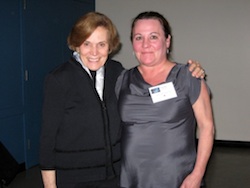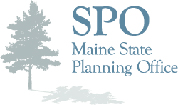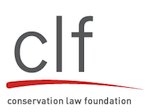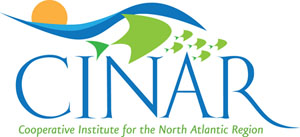By Lee Bumsted
The Census of Marine Life was the focal point for the Ocean Literacy Summit, held at the University of New Hampshire in Durham on November 12. The conference brought together 150 scientists and educators from several states.
It was the third biennial summit hosted by the New England Ocean Science Education Collaborative (www.neosec.org). NEOSEC member institutions include aquariums, marine science and research centers, and universities.

Dr. Sylvia Earle and Theresa Torrent-Ellis.
Concurrent morning sessions provided attendees opportunities to share ideas on teaching children and adults about the diversity of the ocean. In one, educators were encouraged to have their students contribute to the Encyclopedia of Life (www.eol.org), an online field guide. Participants got down on their hands and knees in another session to piece together puzzles based on data from Northeastern Regional Association of Coastal Ocean Observing Systems buoys. In a third, presenters shared ways to use live online feeds of scientists working underwater to engage schoolchildren in the scientific process.
The keynote address, “Discoveries of the Census of Marine Life: Making Ocean Life Count,” was offered by Paul Snelgrove. He is a biological oceanographer from Memorial University in St. John’s, Newfoundland and the Chair of Census of Marine Life Synthesis. Dr. Snelgrove provided an overview of the census (www.coml.org), a global database developed by 2700 researchers from more than 80 nations. He noted one of the highlights of the census for him was the incredible diversity of microbes uncovered.

An interactive exercise during a morning session at the Ocean Literacy Conference called “From Intertidal to Deep Sea: Monitoring Ecosystem Diversity.”
A lively plenary session, “Putting the Census of Marine Life in Context,” featured four panelists from New England who are engaged in the census. Ann Bucklin, of the University of Connecticut, is a principal investigator with the Census of Marine Zooplankton. She noted that the project hasn’t addressed what drives biodiversity levels yet, as it has been more focused on counting species, and she sees that as a next step. Jeffrey Bolster, of the University of New Hampshire, worked on the History of Marine Animal Populations. He offered evidence, such as old logbooks of commercial fishermen working from Massachusetts and Maine homeports, of how severely fish populations have declined in the past 200 years.
Dr. Sylvia Earle was greeted by a standing ovation when she stepped to the podium at the conference’s conclusion. A noted oceanographer and speaker, she is a member of the Census of Marine Life’s U.S. National Committee. Her talk was hosted by the Gulf of Maine Marine Education Association. She has written recently of her diving into the Gulf of Mexico to observe the effects of the massive oil spill there.
“The Census of Marine Life gives us an edge in understanding what is going on,” Dr. Earle told the audience. She said that we are getting more tools to assess the damage we are doing to the ocean and the wildlife it holds, although we still lack important research equipment. “If we have a catastrophe in the Gulf of Maine, where is the submersible to go down and check it out?” she asked.

Keynote speaker Paul Snelgrove.
Earle said we need to invest in new ways to explore the ocean. “We have the power to anticipate the future,” she stated, and a responsibility to the next generations to act on that knowledge.
A fourth summit to promote ocean literacy will be hosted by the New England Ocean Science Education Collaborative two years from now, in a location to be determined.
###
Note: Sylvia Earle’s most recent book, “The World is Blue,” was reviewed in the March 2010 issue, http://www.gulfofmaine.org/gomt/?cat=4&paged=3. It is now available in a paperback edition as well.
Print


















